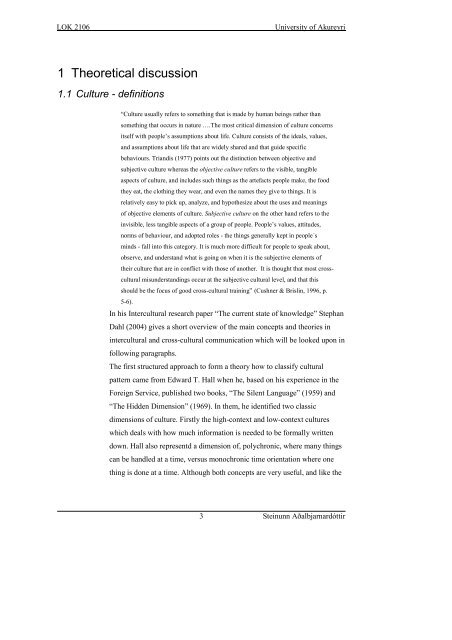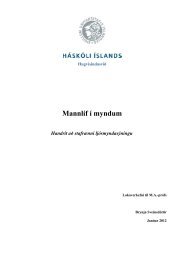Cross-Cultural Communication Do Icelanders have the ... - Skemman
Cross-Cultural Communication Do Icelanders have the ... - Skemman
Cross-Cultural Communication Do Icelanders have the ... - Skemman
You also want an ePaper? Increase the reach of your titles
YUMPU automatically turns print PDFs into web optimized ePapers that Google loves.
LOK 2106 University of Akureyri<br />
1 Theoretical discussion<br />
1.1 Culture - definitions<br />
“Culture usually refers to something that is made by human beings ra<strong>the</strong>r than<br />
something that occurs in nature ….The most critical dimension of culture concerns<br />
itself with people’s assumptions about life. Culture consists of <strong>the</strong> ideals, values,<br />
and assumptions about life that are widely shared and that guide specific<br />
behaviours. Triandis (1977) points out <strong>the</strong> distinction between objective and<br />
subjective culture whereas <strong>the</strong> objective culture refers to <strong>the</strong> visible, tangible<br />
aspects of culture, and includes such things as <strong>the</strong> artefacts people make, <strong>the</strong> food<br />
<strong>the</strong>y eat, <strong>the</strong> clothing <strong>the</strong>y wear, and even <strong>the</strong> names <strong>the</strong>y give to things. It is<br />
relatively easy to pick up, analyze, and hypo<strong>the</strong>size about <strong>the</strong> uses and meanings<br />
of objective elements of culture. Subjective culture on <strong>the</strong> o<strong>the</strong>r hand refers to <strong>the</strong><br />
invisible, less tangible aspects of a group of people. People’s values, attitudes,<br />
norms of behaviour, and adopted roles - <strong>the</strong> things generally kept in people´s<br />
minds - fall into this category. It is much more difficult for people to speak about,<br />
observe, and understand what is going on when it is <strong>the</strong> subjective elements of<br />
<strong>the</strong>ir culture that are in conflict with those of ano<strong>the</strong>r. It is thought that most crosscultural<br />
misunderstandings occur at <strong>the</strong> subjective cultural level, and that this<br />
should be <strong>the</strong> focus of good cross-cultural training” (Cushner & Brislin, 1996, p.<br />
5-6).<br />
In his Intercultural research paper “The current state of knowledge” Stephan<br />
Dahl (2004) gives a short overview of <strong>the</strong> main concepts and <strong>the</strong>ories in<br />
intercultural and cross-cultural communication which will be looked upon in<br />
following paragraphs.<br />
The first structured approach to form a <strong>the</strong>ory how to classify cultural<br />
pattern came from Edward T. Hall when he, based on his experience in <strong>the</strong><br />
Foreign Service, published two books, “The Silent Language” (1959) and<br />
“The Hidden Dimension” (1969). In <strong>the</strong>m, he identified two classic<br />
dimensions of culture. Firstly <strong>the</strong> high-context and low-context cultures<br />
which deals with how much information is needed to be formally written<br />
down. Hall also representd a dimension of, polychronic, where many things<br />
can be handled at a time, versus monochronic time orientation where one<br />
thing is done at a time. Although both concepts are very useful, and like <strong>the</strong><br />
3<br />
Steinunn Aðalbjarnardóttir

















